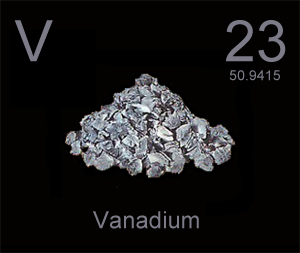Vanadium is a chemical element with the symbol V and atomic number 23. It is a hard, silvery gray, ductile and malleable transition metal. The element is found only in chemically combined form in nature, but once isolated artificially, the formation of an oxide layer stabilizes the free metal somewhat against further oxidation. Andrés Manuel del Río discovered compounds of vanadium in 1801 by analyzing a new lead-bearing mineral he called "brown lead," and presumed its qualities were due to the presence of a new element, which he namederythronium (Greek for "red") since, upon heating, most of its salts turned from their initial color to red. Four years later, however, he was convinced by other scientists that erythronium was identical to chromium. Chlorides of vanadium were generated in 1830 by Nils Gabriel Sefström who thereby proved that a new element was involved, which he named "vanadium" after the Germanic goddess of beauty and fertility, Vanadís (Freyja). Both names were attributed to the wide range of colors found in vanadium compounds. Del Rio's lead mineral was later renamed vanadinite for its vanadium content. Although Berzelius claimed to have first isolated vanadium in the 1830s, in 1867 Henry Enfield Roscoe showed that he had only obtained the oxide, and finally in 1869 Roscoe demonstrated a method to obtain the pure element.
hard, silvery gray, ductile and malleable transition metal. The element is found only in chemically combined form in nature, but once isolated artificially, the formation of an oxide layer stabilizes the free metal somewhat against further oxidation. Andrés Manuel del Río discovered compounds of vanadium in 1801 by analyzing a new lead-bearing mineral he called "brown lead," and presumed its qualities were due to the presence of a new element, which he namederythronium (Greek for "red") since, upon heating, most of its salts turned from their initial color to red. Four years later, however, he was convinced by other scientists that erythronium was identical to chromium. Chlorides of vanadium were generated in 1830 by Nils Gabriel Sefström who thereby proved that a new element was involved, which he named "vanadium" after the Germanic goddess of beauty and fertility, Vanadís (Freyja). Both names were attributed to the wide range of colors found in vanadium compounds. Del Rio's lead mineral was later renamed vanadinite for its vanadium content. Although Berzelius claimed to have first isolated vanadium in the 1830s, in 1867 Henry Enfield Roscoe showed that he had only obtained the oxide, and finally in 1869 Roscoe demonstrated a method to obtain the pure element.
Large amounts of vanadium ions are found in a few organisms, possibly as a toxin. The oxide and some other salts of vanadium have moderate toxicity. Particularly in the ocean, vanadium is used by some life forms as an active center of enzymes, such as the vanadium bromoperoxidase of some ocean algae. Vanadium is probably a micronutrient in mammals, including humans, but its precise role in this regard is unknown.